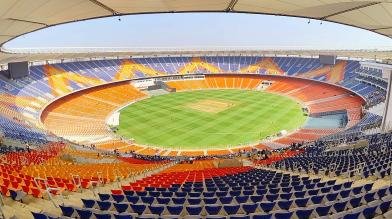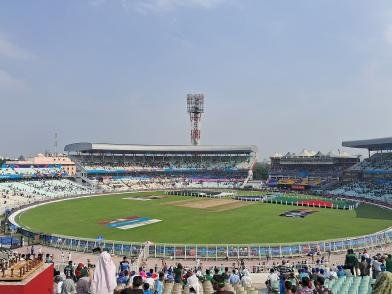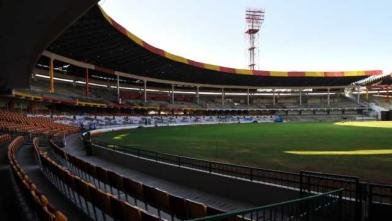💗The Heartbeat of Indian Cricket
Welcome to the iconic Wankhede Stadium, a cricketing fortress in Mumbai, India, where history, passion, and unforgettable moments converge. Home to the Mumbai Indians and the Indian cricket team, this stadium has witnessed legendary performances and electrifying atmospheres. Explore its rich legacy, modern amenities, and vibrant fan experience below.
History of the Stadium
Construction and Origin: Wankhede Stadium was built in 1974, named after Barrister Sheshrao Krishnarao Wankhede, a prominent politician and then-secretary of the Mumbai Cricket Association (MCA). The stadium was constructed in approximately 13 months, a remarkable feat, to address disputes over ticket allocation between the MCA and the Cricket Club of India (CCI), which owned the nearby Brabourne Stadium. The MCA, led by S.K. Wankhede, envisioned a dedicated cricketing venue for Mumbai, resulting in this iconic ground near Churchgate.
Purpose: The primary purpose was to establish a world-class cricketing facility for Mumbai, India’s cricket capital, independent of CCI’s Brabourne Stadium. It aimed to host international and domestic matches, fostering Mumbai’s cricketing legacy.
Significant Historical Events:
- 2011 ICC Cricket World Cup Final: India defeated Sri Lanka by 6 wickets, becoming the first nation to win the World Cup on home soil, sealed by MS Dhoni’s iconic six.
- Sachin Tendulkar’s Farewell: The cricketing legend played his 200th and final Test match here in 2013, an emotional moment for fans worldwide.
- Ravi Shastri’s Six Sixes: In 1984–85, Shastri hit six sixes in an over during a Ranji Trophy match, en route to the fastest double-century in first-class cricket (200* off 123 balls).
- 50th Anniversary Celebration (2024): The MCA marked 50 years of Wankhede with a Guinness World Record for the largest sentence formed using 14,505 cricket balls.
Location and Accessibility
Location: Wankhede Stadium is located at D Road, Churchgate, Mumbai, Maharashtra 400020, India, near the scenic Marine Drive in South Mumbai.
How to Reach:
- By Rail: The stadium is a short walk from Marine Lines and Churchgate railway stations, both served by Mumbai’s local trains (Western Line). Churchgate is approximately 1 km away, and Marine Lines is even closer, with Gate No. 4 (Sachin Tendulkar Stand) just outside the station.
- By Road: Taxis, auto-rickshaws, and app-based cabs (Ola, Uber) are readily available. The stadium is accessible via Marine Drive and other major roads like Netaji Subhash Chandra Bose Road.
- By Air: Chhatrapati Shivaji Maharaj International Airport is about 22 km away (45–60 minutes by car, depending on traffic). Visitors can take a taxi or cab directly to Churchgate. Prepaid taxi counters at the airport offer fixed rates to South Mumbai.
- Public Transport: BEST buses connect various parts of Mumbai to Churchgate and Marine Drive, with stops near the stadium.
Nearby Landmarks:
- Marine Drive, a 3.6-km-long promenade, is a 5-minute walk away.
- Nariman Point, a business district, is 2 km south.
- Historic cricket clubs like Hindu Gymkhana, Parsi Gymkhana, and CCI’s Brabourne Stadium are in close proximity.
Architecture and Design
Seating Capacity: Post-2011 renovations, Wankhede Stadium has a seating capacity of approximately 33,108, reduced from 45,000 to enhance spectator comfort with bucket seating. It includes VIP boxes, corporate sections, general seating, and wheelchair-accessible areas.
Unique Architectural Features:
- Suspended Cantilever Roofs: Designed by Shashi Prabhu & Associates, the Teflon fabric roofs are lightweight, heat-resistant, and free of beam supports, ensuring unobstructed views for spectators.
- Ventilation System: Exhaust fans on the roof draw out hot air, allowing cool sea breezes from the Arabian Sea to flow in, enhancing comfort.
- Elevators: 20 elevators serve the North and South stands, improving accessibility.
- Stands Named After Legends: Stands honor Mumbai cricketing greats like Vijay Merchant, Sunil Gavaskar, and Sachin Tendulkar.
Field Dimensions and Pitch Characteristics:
- Boundary Length: Uniform at 70 meters, with square boundaries at 64–68 meters and straight boundaries at 68–72 meters, making it a relatively compact ground.
- Pitch: The red-soil pitch offers extra bounce, favoring batsmen but providing assistance to swing bowlers early due to the sea breeze. Spinners gain an edge in the later stages of Test matches. In limited-overs games, dew can make the pitch batting-friendly in the second innings, encouraging captains to chase.
Famous Matches and Events
Memorable Matches:
- 2011 Cricket World Cup Final: India’s historic win over Sri Lanka, with Gautam Gambhir’s 97 and Dhoni’s match-winning six.
- 2023 Cricket World Cup: Hosted five matches, including India’s record-breaking 357-run semi-final win over South Africa, where Mohammed Shami took 7/57, and Virat Kohli scored his 50th ODI century.
- 2016 Test vs England: Virat Kohli’s 235 powered India to 631, their highest Test total at Wankhede.
- IPL Classics: As the home of Mumbai Indians, Wankhede has hosted thrilling IPL matches, including MI’s title wins in 2013, 2015, 2017, 2019, and 2020.
Records Set:
- Highest Test Total: 604/6 by West Indies vs India (1974/75).
- Lowest Test Total: 93 by Australia vs India (2004/05).
- Highest ODI Individual Score: 186* by Sachin Tendulkar vs New Zealand (2010).
- Best ODI Bowling: 6/29 by Venkatesh Prasad vs Pakistan (2004/05).
- Fastest Double-Century: Ravi Shastri’s 200* in 123 balls (Ranji Trophy, 1984–85).
- Most ODI Centuries: Virat Kohli broke Sachin Tendulkar’s record with his 50th ODI century in 2023.
- Best World Cup Bowling: Mohammed Shami’s 7/57 vs South Africa (2023).
Other Events: While primarily a cricket venue, Wankhede has hosted ceremonial events and MCA celebrations, such as the 50th-anniversary festivities in 2024.
Facilities
Spectator Amenities:
- Seating: Comfortable bucket seats across general, VIP, and corporate sections. The Sachin Tendulkar Stand, covering one-third of the stadium, is a fan favorite for its vibrant energy.
- Food and Beverage: Multiple food courts offer a variety of options, though prices are noted to be high. Level 2 stands provide complimentary food and drinks for premium ticket holders.
- Parking: Limited to approximately 600 spaces, primarily for VIPs and hospitality box holders. Public parking is challenging, with nearby streets often congested on match days.
- Washrooms: 53 men’s and 54 women’s washrooms, though hygiene can deteriorate during long matches. Recent upgrades aim to address this.
- Accessibility: Wheelchair-friendly entrances, ramps, and seating ensure inclusivity.
Player Facilities:
- Dressing Rooms: Renovated in 2023 with modern seating, flooring, dining areas, physiotherapy corners, and lavatories, designed with input from former and current Mumbai cricketers.
- Practice Areas: Limited on-site practice facilities due to space constraints. Teams use the main stadium sidelines, nearby Brabourne Stadium, or MCA’s Sharad Pawar Cricket Academy at Bandra-Kurla Complex (BKC), which includes indoor facilities.
Media and Broadcasting:
- 59 corporate hospitality boxes and dedicated media centers support broadcasting needs.
- 48 turnstiles and 6 gates streamline spectator and media access.
- Giant screens and sight-screen extensions enhance visibility for live and televised audiences.
Unique Features
Standout Aspects:
- Cantilever Roof Design: Ensures clear sightlines and a comfortable environment with sea breeze circulation.
- Floodlights: Installed in 1996, enabling thrilling night matches, especially IPL games.
- Compact Boundaries: Short boundaries (64–72 meters) create a high-scoring, spectator-friendly environment.
Special Spectator Experiences:
- Fan Zones: The Sachin Tendulkar Stand is renowned for its electric atmosphere, with fans creating a carnival-like vibe.
- Giant Screens: Enhance visibility, though some lower-tier seats (first 5–7 rows of Level 1) face view obstructions due to security fencing.
- Crowd Energy: The stadium’s compact layout amplifies cheers, with roars audible miles away, especially during IPL matches.
Upcoming Events
Future Matches:
- IPL 2025: Wankhede will host Mumbai Indians’ home matches, typically from March to May. Exact schedules are announced closer to the season.
- International Matches: Potential Test, ODI, or T20I matches may be scheduled, pending BCCI and ICC announcements. The last international match was India vs England (T20I, February 2, 2025).
- Domestic Cricket: Ranji Trophy and other MCA-hosted tournaments will continue, with Wankhede as a key venue.
Ticket Booking:
- Platforms: Tickets for IPL and international matches are available on official platforms like BookMyShow, Paytm, Insider, and the IPL website. MCA’s official website (www.mumbaicricket.com) also provides ticketing details.
- Price Range: General stand tickets start at ₹800, while premium seats (VIP boxes, corporate sections) can range from ₹5,000 to ₹35,000 for high-profile matches like MI vs RCB.
- Tips: Book early, as popular matches sell out quickly. Check seating categories (general, VIP, accessible) to match your preferences.
Fan Experience
Reviews and Stories:
- A Tripadvisor reviewer described the atmosphere during an India vs England T20I as “exhilarating,” praising the friendly crowd and vibrant energy, despite England’s loss. They noted the entry process as “drawn-out” but worthwhile.
- Another fan, who visited 30–35 times, called Wankhede a “must-do” for cricket lovers, highlighting the adrenaline rush and crowd roars but lamenting the 10 PM music curfew.
- Complaints include uncomfortable seating for larger individuals, expensive food, and view obstructions in lower-tier seats due to fencing. Fans hope for future renovations to address these.
Atmosphere and Crowd Energy:
- Wankhede is celebrated as India’s premier cricketing cauldron, with a compact layout amplifying fan enthusiasm. The Sachin Tendulkar Stand is the epicenter of passion, where fans chant, wave flags, and create a festival-like vibe.
- During IPL matches, the stadium transforms into a sea of blue, with Mumbai Indians supporters delivering unmatched energy. The 2011 World Cup final and MI’s title wins remain etched in fans’ memories.
- Social media posts on X echo this, with fans calling Wankhede the “best stadium for cricket atmosphere” and a “pilgrimage site” for cricket lovers.
Plan Your Visit to Wankhede Stadium
Whether you’re cheering for Mumbai Indians in the IPL or witnessing an international clash, Wankhede Stadium promises an unforgettable experience. Book your tickets, soak in the electric atmosphere, and become part of Mumbai’s cricketing legacy!







